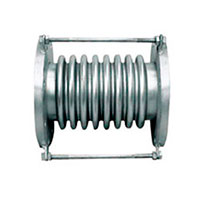Compensators
Description of Section "Compensators"
Compensators are devices designed to compensate for movements, thermal deformations, vibrations, and displacements in pipelines. They play a crucial role in protecting pipeline systems from destruction and extending their service life.
Purpose of Compensators
Compensators are used to prevent the negative effects of various factors on pipelines, such as:
- Thermal expansion: When heated, pipes elongate, which can lead to deformation or destruction.
- Vibrations: Occur during the operation of pumping equipment or due to external influences.
- Displacements: Can be caused by soil settlement or pipeline supports shifting.
- Dynamic loads: For example, water hammer.
The installation of compensators helps minimize these risks and ensures the safe operation of the pipeline system.
Main Types of Compensators
1. Bellows Compensators
Bellows compensators are the most common due to their versatility and reliability.
- Design: The main element is a bellows—a corrugated metal shell made of stainless steel.
- Types of bellows compensators:
- Axial (for compensating longitudinal movements).
- Lateral (for compensating transverse displacements).
- Angular (for compensating angular deformations).
- Universal (capable of handling various types of deformations).
- Advantages:
- Leak-tightness.
- Compactness.
- Durability (service life matches that of the pipeline).
- Operability in extreme conditions.
Used in power engineering, chemical industries, heating networks, and other sectors.
2. Packing Gland Compensators
Packing gland compensators consist of two nozzles with the space between them sealed by a gland packing.
- Features:
- Used for axial deformations.
- Operating temperature for water - up to +200 °C; for steam - up to +300 °C.
- Disadvantages:
- Require regular maintenance.
- Shorter service life compared to other types of compensators.
- Used in heating networks on main pipelines.
3. Lens Compensators
Lens compensators consist of one or several welded lenses.
- Design features:
- The lenses are made of thin-walled steel and have high rigidity.
- Advantages:
- High resistance to thermal expansion.
- Used in heat exchangers, gas ducts, and ventilation systems.
4. Rubber Compensators
Rubber compensators are flexible inserts for pipelines.
- Materials:
- Elastomers (e.g., EPDM for water environments or NBR for petroleum products).
- Advantages:
- Flexibility and vibration resistance.
- Easy installation without the need for sealing gaskets.
- Used in water supply, sewage systems, and petrochemical industries.
5. Fabric Compensators
Fabric compensators are primarily used in systems with gaseous media.
- Design features:
- Made of multilayer heat-resistant materials ("sandwich" structure).
- Used in ventilation systems and gas ducts.
